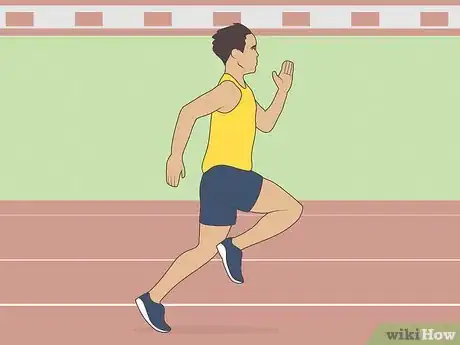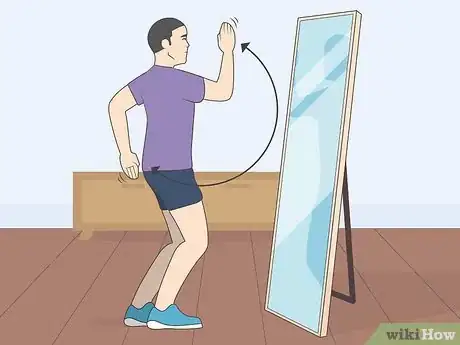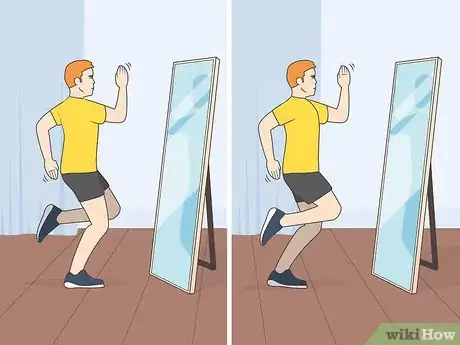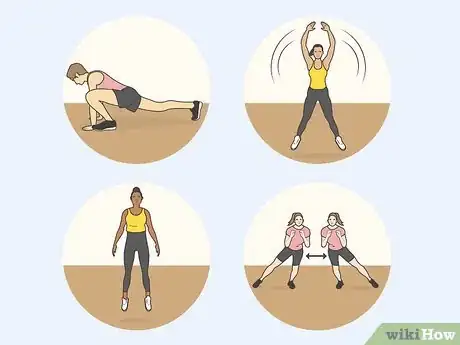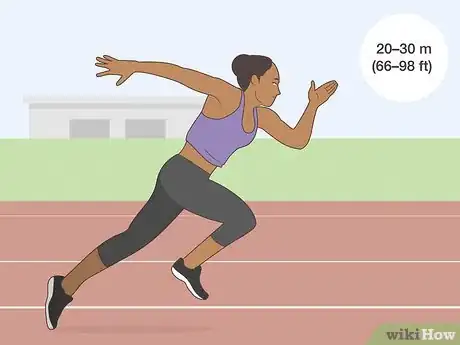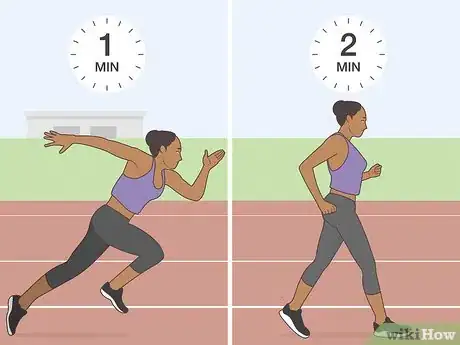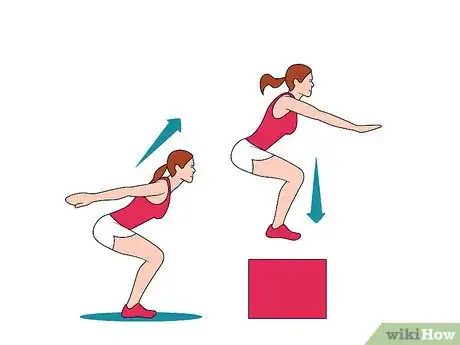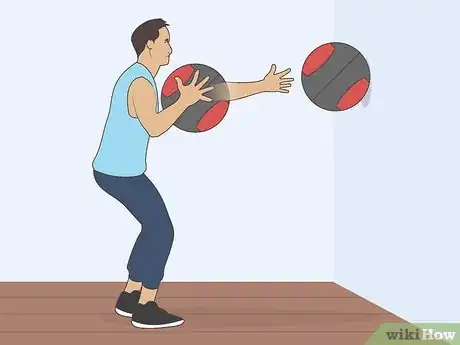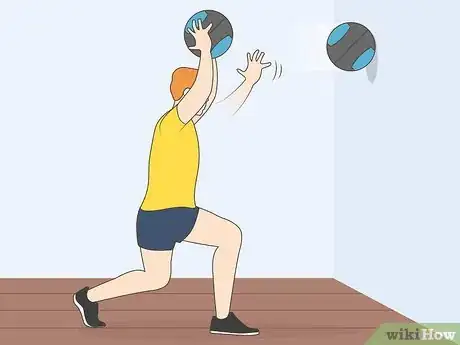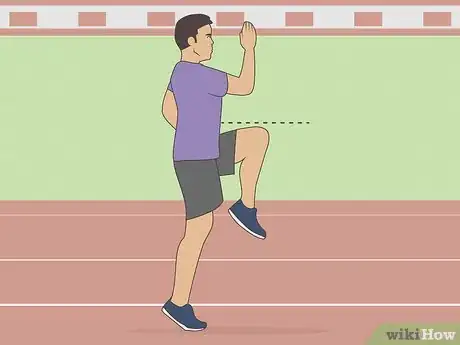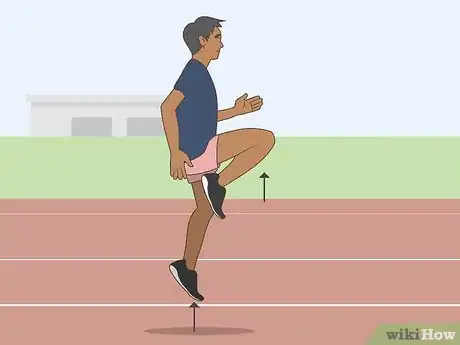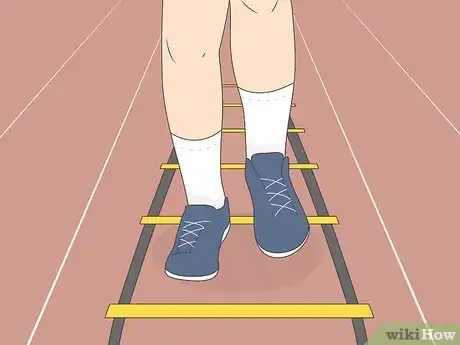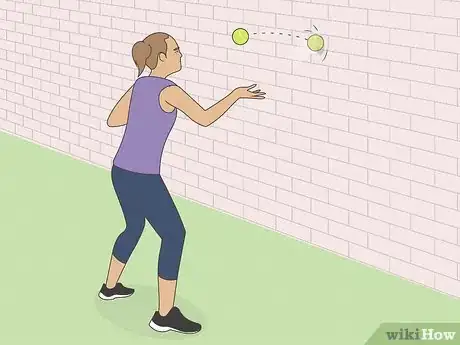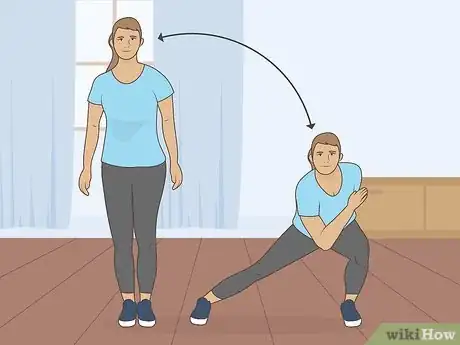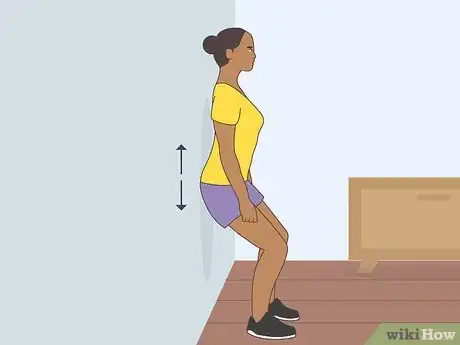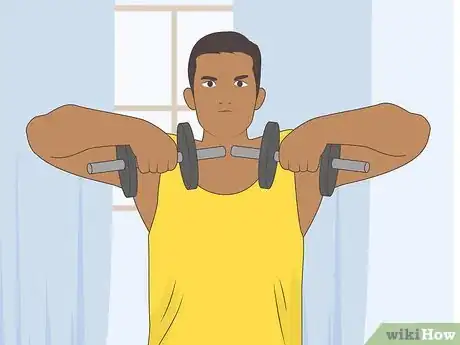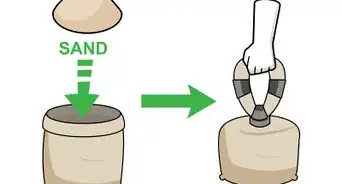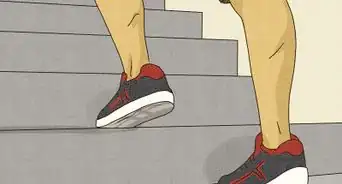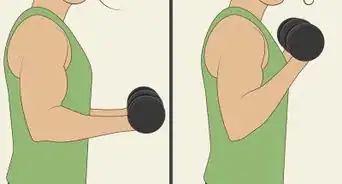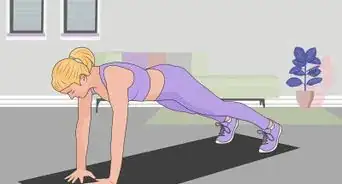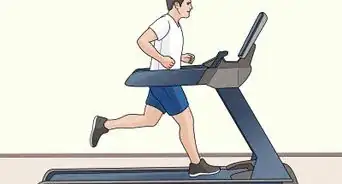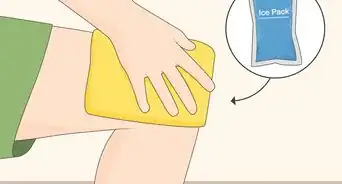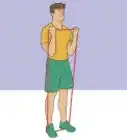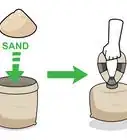This article was co-authored by Francisco Gomez and by wikiHow staff writer, Megaera Lorenz, PhD. Francisco Gomez is the Head Coach at the FIT Potato Gym, a training gym established in 2001 in the San Francisco Bay Area. Francisco is a former competitive runner who helps endurance athletes train for major marathons like the Boston Marathon. Francisco specializes in Injury Rehab, Flexibility, Marathon Training, and Senior Fitness. He has a B.S. in Nutrition and Exercise Physiology & Running.
There are 24 references cited in this article, which can be found at the bottom of the page.
This article has been viewed 26,184 times.
Whether you’re a runner, a basketball player, or a martial artist, speed is an advantage for any athlete! Get quicker on your feet by incorporating speed drills and sprints into your regular workout routine. Speed also requires strength and stability, so don’t forget to do a little strength training each week.
Steps
Form Exercises for Runners
-
1Improve your running form and stamina with strides. Strides are slower and easier than sprints, so they allow you to focus on running correctly instead of wearing yourself out.[1] To do strides, run for 15-30 seconds at your fastest comfortable pace—that is, the fastest you can run while still moving smoothly and not getting out of breath. Aim for about 8 sets of strides lasting 20-30 seconds each, with about 1-2 minutes of easy jogging between sets.[2]
- Strides work best when you incorporate them into a light, easy run. Try to do strides 2-4 times a week, incorporating them into the second half of a longer run.
- Try to run at about 70-80% of your maximum speed during a stride.
- With practice, you’ll be able to run more smoothly and comfortably at faster speeds.
-
2Do “fast arms” exercises to improve upper body form and speed for running. Stand in front of a mirror with your knees slightly bent and your feet shoulder-width apart. Bend your arms 90° at each elbow. Position your hands on either side of you so one hand is next to your face and the other is next to your butt. Keeping your elbows bent, pump your arms as if you were sprinting as fast as you can for a full 20 seconds. Switch the positions of your hands with each pump.[3] This exercise will not only improve your upper body speed but will also help you master better form for running.
- Your hands should brush past your pockets each time they return to the starting position. Don’t let your shoulders start to hunch up.
- When you’re starting out, do 5 sets lasting 20 seconds each. As you build strength and speed, increase each repetition to 30 seconds. Aim to do this type of drill 2-3 times per week along with other speed and agility exercises, or incorporate them into your regular warmup routine.[4]
- Your arms actually help you run faster when they work together with your legs![5]
Advertisement -
3Coordinate your arm and leg movements for running with “fast feet” drills. Stand facing a mirror with your knees and shoulders facing forward and your feet shoulder-width apart. Bend your elbows at 90° and position one hand by your face and one by your rear, just like you would for a “fast arms” drill. This time, pump your arms while also running in place as fast as you can, bringing your knees up about half as high as you can raise them. Keep sprinting in place for about 20 seconds, then rest for a minute.[6]
- Stay on the balls of your feet as you run in place. Don’t let your heels touch the ground.
- Try to let your feet touch the ground as many times as possible in 20 seconds.[7] Do 5 sets of 20 seconds each with a 1-minute rest in between. Aim to do this exercise 2-3 times a week, along with “fast arms” and other speed drills.
- To keep track of your progress from one drill to another, count how many times your right foot touches the ground in 20 seconds. You should notice an improvement over time!
Endurance and Stamina Drills
-
1Start any run with a dynamic warmup to prevent injury. Whether it’s a light jog or an intense sprint, always warm up before you run. This will improve circulation and make you less likely to strain your muscles or put stress on your heart. For example, do 2-3 sets of each of the following exercises:[8]
- Spider-Man stretches. Get into a plank position, then bring your right knee up to your right elbow with your foot flat on the ground. Hold this position for 3-4 seconds, then switch sides. Do 8-10 reps.
- Bounces. Stand with your knees slightly bent and bounce on your feet. Lower your heels all the way to the ground, but keep your weight on the balls of your feet. Bounce 12-15 times per set.
- Jumping jacks. Do 12-15 reps and rest 30 seconds between sets.
- Lateral shuffles. Bend your knees slightly and plant your feet shoulder-width apart, then shuffle sideways, like a crab, about 5–10 metres (16–33 ft). Walk back to the starting position and repeat the shuffle 2-3 times.
-
2Practice 20–30 m (66–98 ft) sprints to build speed and endurance. As you perfect your form doing slower runs, start incorporating faster sprints into your routine. Run about 20–30 metres (66–98 ft), going as fast as you possibly can. When you reach the end of the running distance, walk back to the start, then rest for 30-45 seconds. Repeat the sprint 4 or 5 times.[9]
- As you get more comfortable with intense sprints, you can work on increasing the distance you cover and the number of reps you do in a session.
- Do sprints or other high-intensity or high-speed workouts no more than once or twice a week.[10]
-
3Boost your overall fitness with high-intensity interval training. High-intensity interval training, or HIIT, can make you more powerful and quicker on your feet. It’s also great for boosting endurance![11] To do HIIT, pick a favorite cardio exercise, like running or cycling, and do a short workout (e.g., 20-30 minutes) in which you switch between going at an easy pace and going as fast as you can. Do a HIIT workout once or twice a week.[12] For example, you might:[13]
- Start with a 5-minute warm up at a medium pace.
- Sprint for 1 minute, as fast as you can.
- Switch to a comfortable run for 2 minutes.
- Continue to switch between 1-minute sprints and lighter 2-minute runs for the next 10-15 minutes.
- Finish with a 5-minute cooldown, e.g., walking at an easy pace.
-
4Do long, low-speed runs at least once a week to max out your stamina. Slower runs help build up your endurance so that you can train longer and harder. At least once a week, do a long, slow run at a light to moderate intensity. You’ll find that the more intensive exercise gets easier over time![14]
- For example, you might start out running about 5 kilometres (3.1 mi) at an easy pace once a week, then gradually increase your distance as you build strength and stamina.
Plyometric Exercises
-
1Aim to do plyometric training twice a week. Plyometric exercise builds speed and strength with quick, powerful movements. Fitness experts typically recommend doing plyometrics 2 times a week. Since this kind of exercise is pretty intense, give yourself 2-3 days of rest between sessions.[15]
- If you don’t rest up enough between sessions, you could injure yourself or feel too sore to work out!
- During a session, keep your number of reps small and rest between sets. For example, when you’re starting out with a new exercise, you might do as little as 3 reps or work in 10-second bursts, then rest for up to 2 minutes before moving to the next set.[16]
-
2Build explosive upper body strength with chest passes. To power up, your upper arms and chest, stand and face a wall (or a partner) with your feet shoulder-width apart. Grab a medicine ball and hold it close to your chest with your elbows bent. Pull your arms back slightly, then push through your elbows to throw the ball forcefully.[17]
- If you’re working with a partner, ask them to catch the ball and toss it back to you. If you’re doing the drill with a wall, bounce it hard against the wall and try to catch it as it comes back. Either way, stand about 10 feet (3.0 m) away from your target.
- To make the exercise a little more challenging, use a heavier ball.
-
3Get more power in your shoulders with overhead throws. For this exercise, stand facing a wall. Grab a medicine ball in both hands, then stand with one foot out in front of the other and bend your knees slightly. Raise the ball over and behind your head, then throw it forward against the wall as hard as you can. Catch it when it bounces back, then throw it again.[18]
- This is a great exercise for any activity that requires overhead arm movements, like basketball, swimming, and tennis.
-
4Work your core and boost your reaction time with multi-directional hops. Hops help build power in your legs, but they also require lots of core action to keep you stable.[19] To practice multidirectional hops, set up 2-4 cones or other small objects that you can easily jump over. Jump or hop over them backward and forwards or from side to side. Mix it up by jumping with both feet or hopping on just one.
- For the best results, do 2-4 sets of 4-6 jumps in each direction. Between sets, rest for 45-60 seconds.
-
5Increase your stride length with a “high knees” drill. Going fast isn’t just about taking more steps in a short time. You’ll also go faster if you have a longer stride! Build a bigger stride by sprinting in place while lifting your knees up to hip level, using a motion almost like pedaling a bike.[20] Make sure to use good form while pumping your arms, too![21]
- Do the high-knee sprint 5 times, 20 seconds at a time, with a minute of rest in between each sprint.
- High-knee sprinting will also build stronger leg and core muscles, giving you the strength and endurance you need to go faster.
- Doing squats is another great way to improve your strength and stride length.
Agility and Flexibility Drills
-
1Increase your flexibility and range of motion with dynamic stretches. In a dynamic stretch, you keep moving instead of holding the stretch. These stretches not only help loosen up your joints and muscles, but they also improve your speed and agility! Plus, they’re great for warming up your muscles, so you can make them a part of your regular warmup before cardio. Try stretches such as:[22]
- Torso twists
- Lunges
- Leg swings and arm swings[23]
- Arm circles
- Heel-to-toe walking
-
2Get quicker on your feet with skipping drills. Skipping is fun, and it’s also a great way to build speed and agility. Push up from the ground with the ball of each foot and lift your knees high while pumping the alternate arm up towards your face. Challenge yourself to pick up your feet as quickly as possible with each skip.[24]
- Try to make your skips fast and powerful to build strength as well as speed.
- Start with 5 sets lasting 20 seconds each and rest for 1 minute between each set.
-
3Boost your agility with ladder drills. Lay out an agility ladder on the ground in front of you. Practice stepping with one foot into each space in the ladder as quickly as you can until you reach the end, then turn around and go back the other way. With practice, you’ll get nimbler and quicker at crossing the ladder.[25]
- As you get more confident, try more complicated drills, like hopping into each square with both feet or alternating jumps with your feet together and then slightly apart, so they touch the outer edges of each square.
- If you don’t have access to an agility ladder, draw some chalk lines on the sidewalk or use the lines between floor tiles as guides for your feet.
- Aim to do these drills for about 10 minutes total per session, up to 5 days a week. If you like, you can incorporate them into your regular cardio routine.
-
4Improve upper body reaction time with wall tosses. Stand about 3–4 feet (0.91–1.22 m) away from a wall with an uneven surface, such as brick or cinderblock. Toss a tennis ball underhand so it bounces off the wall, then catch it and toss it again. The bumpy surface of the wall will make the ball bounce in unpredictable ways, so be ready to move fast to catch it![26]
- Do 4-6 sets of this drill, then rest for 1-2 minutes before moving on to another exercise. You can incorporate this kind of drill into your regular cardio routine.
- As you get better at catching the ball, mix it up by throwing and catching with opposite hands.
- You can increase the challenge level even more by shuffling your feet around as you throw and catch the ball.
Strength Training
-
1Do strength training once or twice a week to power up your muscles. Going fast requires power and stability, so take 1-2 days out of the week to work on strength training.[27] Alternate between different muscle groups to avoid imbalances.
- If you don’t have access to a gym, you can still do strength training at home! Focus on body weight exercises or exercises you can do with simple free weights, such as dumbbells.
- In general, make it a goal to do a single set of 12-15 reps of each exercise.[28] However, you may want to start out with fewer reps, such as 8-10, when you’re just beginning.
-
2Target your glutes to power your lower body. If you want to be fast on your feet, you need powerful glutes! Do strengthening exercises like squats, deadlifts, and planks to build up your butt muscles.[29]
- One great workout for your glutes is the kettlebell goblet squat. Hold a kettlebell or dumbbell against your chest and plant your feet a little more than shoulder-width apart. Keeping your back straight and your shoulders back, lower your hips toward the floor as far as you can, then slowly push back up to a standing position.
- Other options include glute bridges, clamshells, and single-leg squats.[30]
-
3Strengthen your hips and knees with walking lateral lunges. Step to one side and let your hip drop down on that side while keeping your toes pointed straight ahead and your knee directly over your foot (not in front of it). Move your other leg over to join the first one, then repeat the step to keep moving sideways. Do 8-10 repetitions.[31]
- This type of exercise will improve your stability and make you less likely to injure yourself when you’re running, biking, or doing other activities that require fast legwork.
-
4Build strength in your knees with knee bends. Stand with your back to a wall with your feet shoulder-width apart and your toes turned out. Slide down the wall slowly by bending your knees until they are positioned directly over your feet, then slowly stand up straight again.[32]
- Do a set of 8-10 repetitions of this exercise.
-
5Perform standing calf raises to shore up your calves and ankles. Few things will slow you down like an injured ankle! To build lower leg strength, stand with your feet hip-width apart on the edge of a step or stool. Hold onto a railing or counter for support. Slowly raise yourself up on your toes, then lower your heels down as far as you can. Aim to do 8-10 repetitions.[33]
- Strengthening your ankles will also make you less likely to injure your knees and hips!
-
6Improve your overall stability with core exercises. Your core, which includes the muscles in your back, sides, and abdomen, needs to be strong so that you can use the rest of your body effectively.[34] To max out your speed and agility, take time to strengthen your core with exercises such as:[35]
- Planks
- Bird-dogs
- Hip bridges, which are also great for your thighs and glutes
-
7Work your arms and shoulders to balance out your lower body. Upper body strength is vital for any activity that requires fast arm movements, whether it’s swimming, basketball, or rowing. It also plays an important role in lower body-focused activities like running. Avoid muscle imbalances and improve your form and posture by doing exercises that target your arms, chest, shoulders, and neck.[36]
- For example, shoulder rows are great for strengthening your shoulders and preventing a hunched-over posture when you run.
- Other great exercises for your upper body include biceps curls, pull-ups, and chest presses.[37]
Expert Q&A
Did you know you can get expert answers for this article?
Unlock expert answers by supporting wikiHow
-
QuestionHow can I learn to run faster?
 Francisco GomezFrancisco Gomez is the Head Coach at the FIT Potato Gym, a training gym established in 2001 in the San Francisco Bay Area. Francisco is a former competitive runner who helps endurance athletes train for major marathons like the Boston Marathon. Francisco specializes in Injury Rehab, Flexibility, Marathon Training, and Senior Fitness. He has a B.S. in Nutrition and Exercise Physiology & Running.
Francisco GomezFrancisco Gomez is the Head Coach at the FIT Potato Gym, a training gym established in 2001 in the San Francisco Bay Area. Francisco is a former competitive runner who helps endurance athletes train for major marathons like the Boston Marathon. Francisco specializes in Injury Rehab, Flexibility, Marathon Training, and Senior Fitness. He has a B.S. in Nutrition and Exercise Physiology & Running.
Fitness Coach Start by stretching before yo run—stretch your hamstrings, quads, and calves. If those muscles are loose, you have a higher chance of running faster. Then, it comes down to your reaction time, so start incorporating a few sprints at the end of your workout to wake up your motor skills and create that natural reaction.
Start by stretching before yo run—stretch your hamstrings, quads, and calves. If those muscles are loose, you have a higher chance of running faster. Then, it comes down to your reaction time, so start incorporating a few sprints at the end of your workout to wake up your motor skills and create that natural reaction. -
QuestionI am not able to gain muscles. What can I do?
 Chris MinCommunity AnswerIt takes time to build up muscles. It will most likely be a couple of months before you notice any cosmetic differences. You could incorporate more protein into your diet and eat a balanced meal for every meal.
Chris MinCommunity AnswerIt takes time to build up muscles. It will most likely be a couple of months before you notice any cosmetic differences. You could incorporate more protein into your diet and eat a balanced meal for every meal.
Warnings
- If you have any injuries or other health concerns, like heart disease or arthritis, talk to your doctor before starting a new exercise routine. They can advise you about what kind of exercise is safe and healthy for you.[39]⧼thumbs_response⧽
References
- ↑ https://www.acefitness.org/education-and-resources/lifestyle/blog/5030/the-benefits-of-speed-training-for-non-athletes/
- ↑ https://trailrunnermag.com/training/workouts/running-strides-how-to.html
- ↑ https://www.nfl.com/news/five-drills-to-increase-your-speed-to-an-nfl-level-0ap1000000246209
- ↑ https://blog.nasm.org/sports-performance/speed-agility-quickness-saq
- ↑ https://www.researchgate.net/publication/324271038_The_role_of_arm_mechanics_during_sprint-running_a_review_of_the_literature_and_practical_applications
- ↑ https://www.nfl.com/news/five-drills-to-increase-your-speed-to-an-nfl-level-0ap1000000246209
- ↑ https://www.acefitness.org/education-and-resources/lifestyle/blog/5030/the-benefits-of-speed-training-for-non-athletes/
- ↑ https://www.acefitness.org/education-and-resources/lifestyle/blog/5030/the-benefits-of-speed-training-for-non-athletes/
- ↑ https://www.acefitness.org/education-and-resources/lifestyle/blog/5030/the-benefits-of-speed-training-for-non-athletes/
- ↑ https://www.acefitness.org/education-and-resources/lifestyle/blog/7276/run-faster-with-just-3-workouts-per-week/
- ↑ https://iopscience.iop.org/article/10.1088/1742-6596/947/1/012045/pdf
- ↑ https://www.acefitness.org/education-and-resources/lifestyle/blog/6752/high-intensity-interval-training/
- ↑ https://www.acefitness.org/education-and-resources/lifestyle/blog/6752/high-intensity-interval-training/
- ↑ https://www.acefitness.org/education-and-resources/lifestyle/blog/7276/run-faster-with-just-3-workouts-per-week/
- ↑ https://www.jospt.org/doi/pdf/10.2519/jospt.2006.2013
- ↑ https://www.acefitness.org/education-and-resources/professional/expert-articles/5869/explosive-plyometric-workout/
- ↑ https://www.fitnesseducation.edu.au/blog/fitness/upper-body-plyometric-exercises/
- ↑ https://www.fitnesseducation.edu.au/blog/fitness/upper-body-plyometric-exercises/
- ↑ https://www.acefitness.org/education-and-resources/professional/expert-articles/7414/how-to-use-plyometrics-to-target-the-core-muscles/
- ↑ https://www.acefitness.org/education-and-resources/lifestyle/blog/5030/the-benefits-of-speed-training-for-non-athletes/
- ↑ https://www.nfl.com/news/five-drills-to-increase-your-speed-to-an-nfl-level-0ap1000000246209
- ↑ https://www.hss.edu/conditions_dynamic-static-stretching.asp
- ↑ https://www.arthritis.org/health-wellness/healthy-living/physical-activity/other-activities/7-dynamic-warm-ups
- ↑ https://www.acefitness.org/education-and-resources/lifestyle/blog/5030/the-benefits-of-speed-training-for-non-athletes/
- ↑ https://intermountainhealthcare.org/blogs/topics/heart/2014/06/4-agility-ladder-drills-for-at-home-workout/
- ↑ https://www.acefitness.org/education-and-resources/professional/expert-articles/6391/7-drills-to-enhance-agility/
- ↑ https://www.acefitness.org/education-and-resources/lifestyle/blog/7276/run-faster-with-just-3-workouts-per-week/
- ↑ https://www.mayoclinic.org/healthy-lifestyle/fitness/expert-answers/strength-training/faq-20058232
- ↑ https://www.acefitness.org/education-and-resources/professional/expert-articles/4848/5-exercises-every-runner-should-be-doing/
- ↑ https://www.issaonline.com/blog/index.cfm/2019/exercises-to-improve-speed-training-that-benefits-everyone
- ↑ https://www.acefitness.org/education-and-resources/professional/expert-articles/4848/5-exercises-every-runner-should-be-doing/
- ↑ https://www.nhs.uk/live-well/exercise/knee-exercises-for-runners/
- ↑ https://health.clevelandclinic.org/how-to-strengthen-your-ankles-and-avoid-sprains-3-easy-exercises/
- ↑ https://www.acefitness.org/education-and-resources/professional/expert-articles/4848/5-exercises-every-runner-should-be-doing/
- ↑ https://www.acefitness.org/education-and-resources/lifestyle/blog/5807/beginner-ab-core-exercises-to-increase-stability-and-mobility/
- ↑ https://www.acefitness.org/education-and-resources/professional/expert-articles/4848/5-exercises-every-runner-should-be-doing/
- ↑ https://blog.ochsner.org/articles/5-upper-body-strength-exercises
- ↑ https://www.acefitness.org/education-and-resources/lifestyle/blog/7276/run-faster-with-just-3-workouts-per-week/
- ↑ https://www.mayoclinic.org/healthy-lifestyle/fitness/in-depth/exercise/art-20047414
